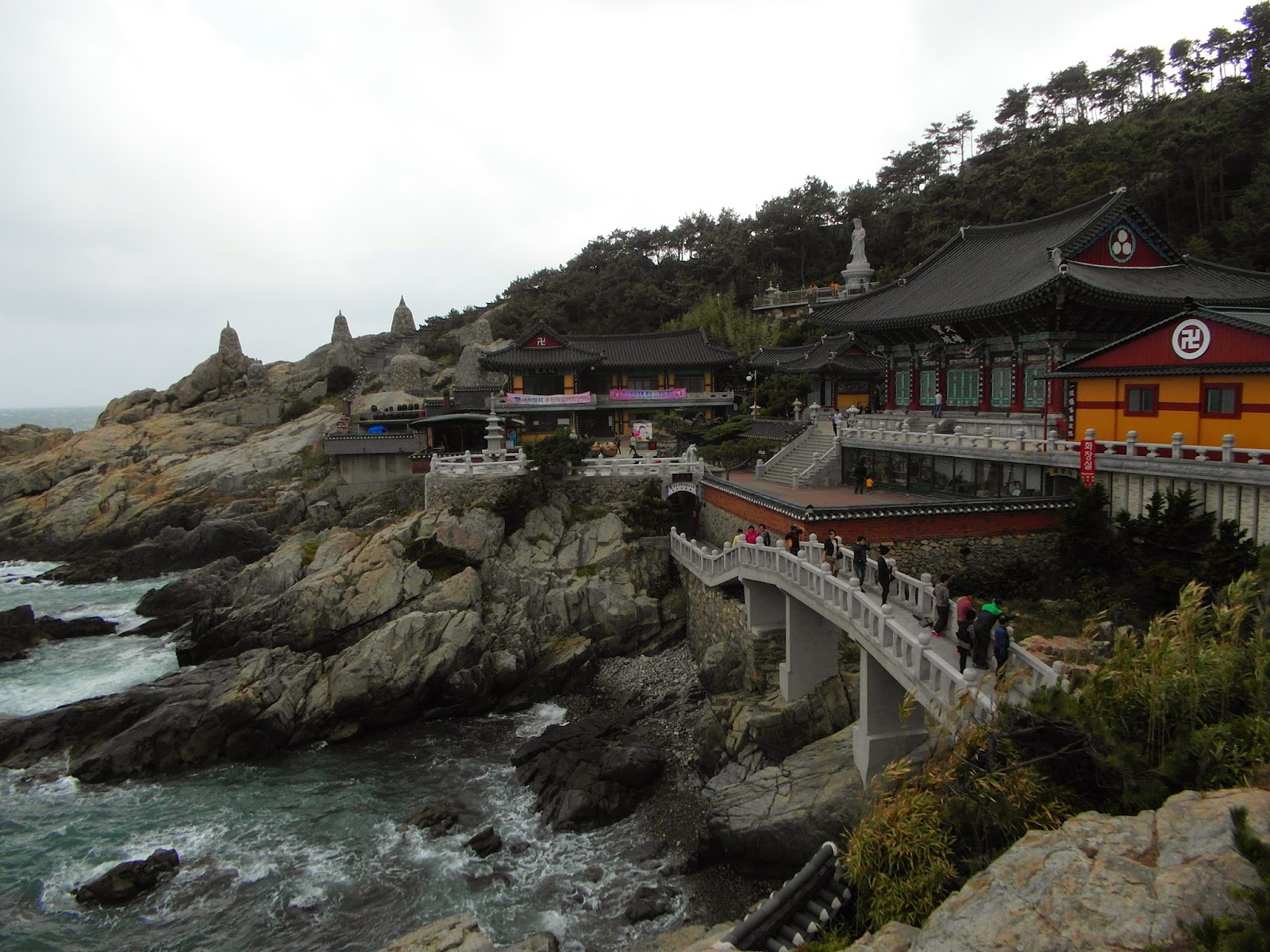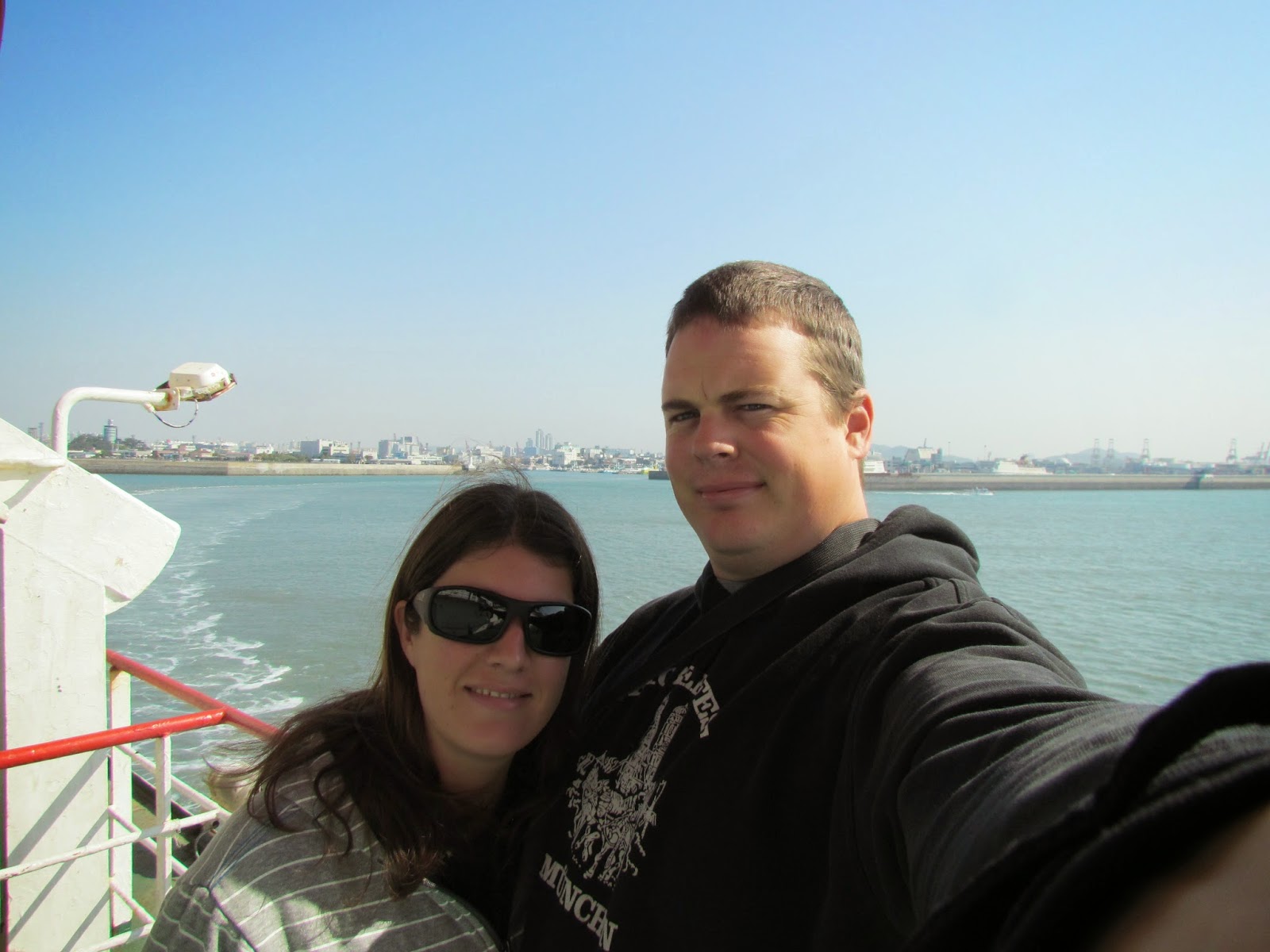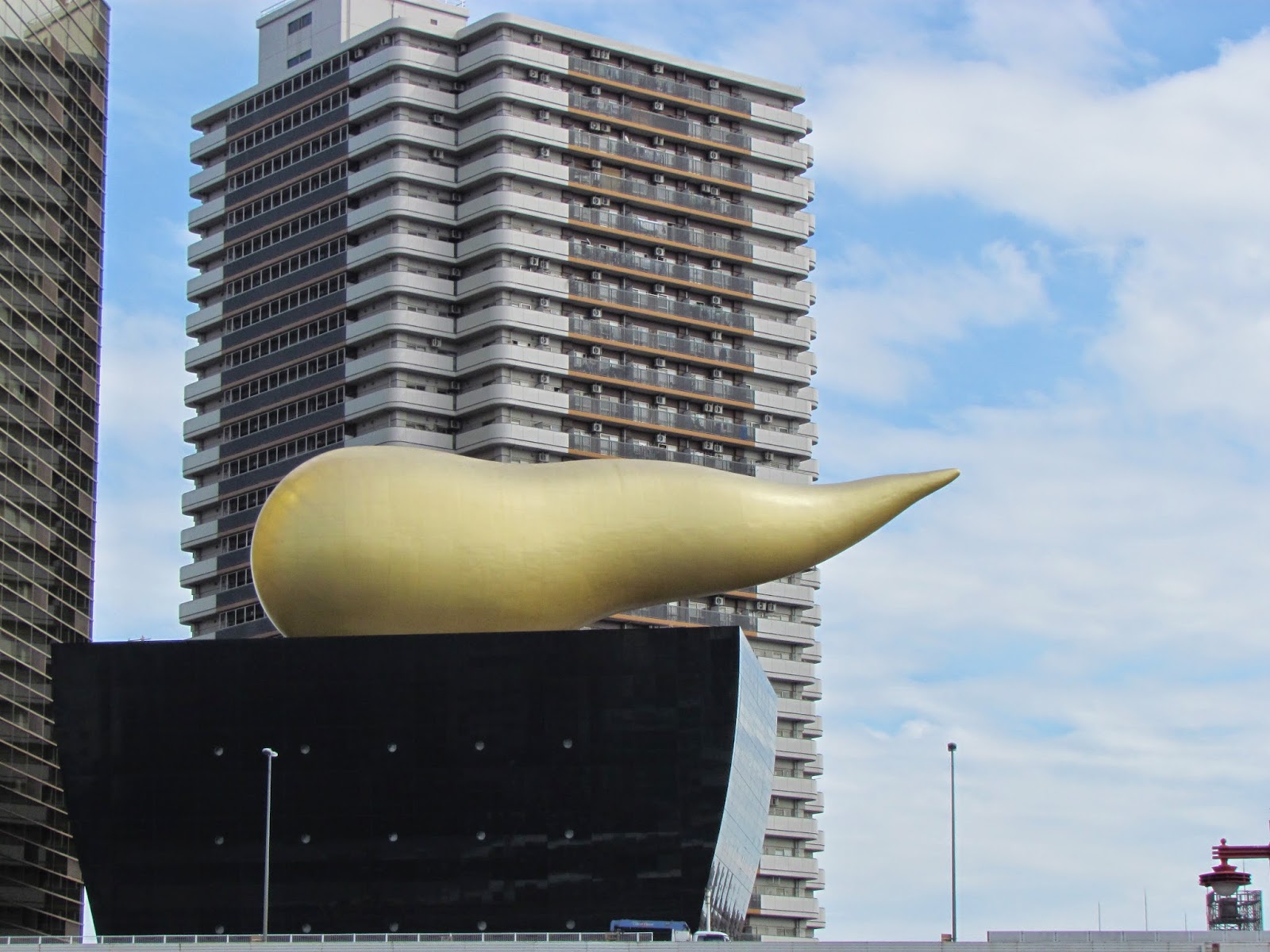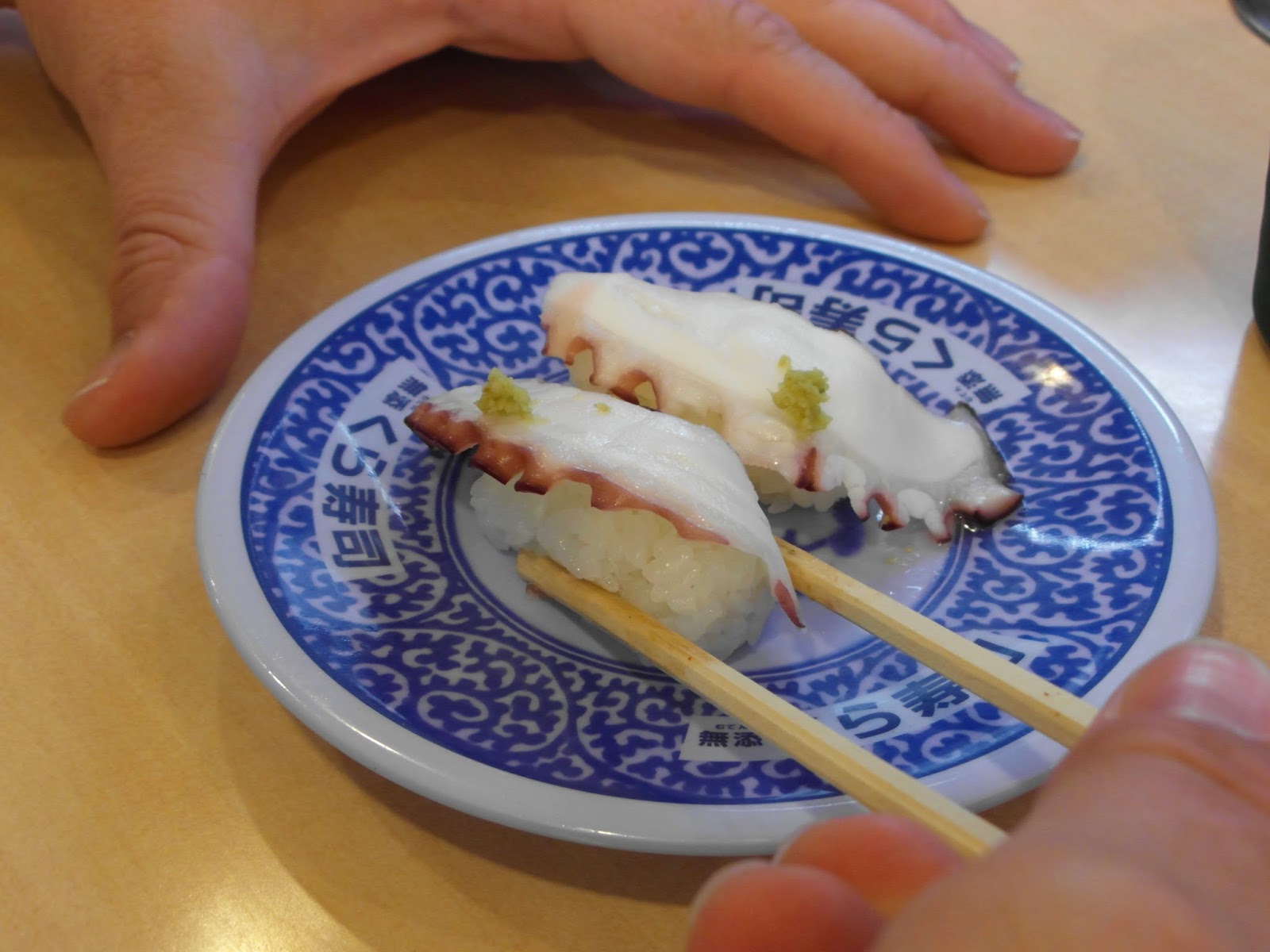After a pretty smooth and comfortable 12 hour ferry ride across the Sea of Japan, we arrived in a brand spanking new country for both of us - South Korea. We had absolutely no idea what to expect from this tiny country (it's less than half the size of New Zealand would you believe?!) but we like to jump in blindly at the deep end.
The ferry arrived in the south-eastern port city of Busan, which is the second largest city in the country. We weren't overly enamoured by the city at first glance, but a lot of port cities have a raw, roughness to them and we only spent a couple of days there which wasn't long enough to really get to explore it properly. We did, however, manage to visit a few sights so we weren't slacking off on the job. First up was Haedong Yonggungsa Temple, a Buddhist temple stunningly located by the sea. Apparently its location is a bit of an anomaly, as most Buddhist temples were built in the mountains to make them easier to defend during a time of persecution from the Confuciust state. And it was indeed a beautiful place to walk around, starting with the row of Chinese zodiac statues at the entrance, crossing a stone bridge and ending with the temple by the water. It was a bit of a mission to get there from Busan, but worth it for the view.
The second temple we visited was Beomeosa (Temple of the Nirvana Fish), one of the best known temples in the country. This one was more traditionally located in the mountains and has a bigger temple complex than Haedong Yonggungsa Temple. It was another peaceful, albeit different location, and a pleasant place to while away a morning.
To round out our sightseeing in Busan we took a walk through Jagalchi fish market, went to the top of Busan Tower for a view over the port, and ended the night with a walk down to Gwangan Bridge (known in English as Diamond Bridge). Every night there's a pretty cheesy light and music show on the bridge where the colours and movements of the lights change with the rhythm of the music, but it's good for a bit of entertainment.
After our busy couple of days in Busan we headed up the coast and inland a bit to Gyeongju, where there are a lot of archaeological and historical sites from it's era as the capital of the ancient kingdom of Silla. We wandered around the Gyeongju Historic Areas (a UNESCO World Heritage Site) which encompasses the ruins of temples and palaces, among other things, left by the ancient kingdom. Afterwards we walked over to the Gyeongju National Museum to get some more history and culture down us. We also took a trip out to the Bulguksa temple complex (which we were rather unimpressed with), then hiked an hour or so up the mountain to the more impressive Seokguram grotto, where a Buddha statue is carved in a small cave. We weren't allowed to take photos to document the moment, but it was pretty cool. And that was our two days in Gyeongju done and dusted.
The final city on our whistle-stop tour of South Korea was, of course, Seoul. The brother of a friend of mine has lived in Seoul for many years, so he kindly met up with us several times to show us around the capital and, most importantly, take us to eat good food we'd never have figured out by ourselves. By this point we were pretty museumed, templed and palaced out, so we were happy to just wander the streets with Damian pointing out interesting things and helping us find new and delicious foods. The one touristy thing we wanted to do was to visit the DMZ, but unfortunately all tours were booked up for the 5 or so days we were in Seoul. Bugger.
And with that, our very brief time in South Korea was up. I don't know if the short amount of time was a contributing factor, but neither of us really took to this country. The main reason being the people - they were very distant and unfriendly, unhelpful and not willing to talk to foreigners. I don't know if that's a cultural thing or not but it was quite surprising. We didn't speak a lick of Korean, nor could we read the language, but we certainly don't expect locals to be able to speak English just to help us. The difference is, that in plenty of other countries where there's been a language barrier the locals are still really friendly and willing to try and interact with and help us. The Koreans did not. At all. So despite there being some beautiful scenery and tasty food, we left the country feeling pretty underwhelmed and uninspired, and definitely in no great hurry to return. Now it was time to get on board another ferry to take us to China.
The ferry arrived in the south-eastern port city of Busan, which is the second largest city in the country. We weren't overly enamoured by the city at first glance, but a lot of port cities have a raw, roughness to them and we only spent a couple of days there which wasn't long enough to really get to explore it properly. We did, however, manage to visit a few sights so we weren't slacking off on the job. First up was Haedong Yonggungsa Temple, a Buddhist temple stunningly located by the sea. Apparently its location is a bit of an anomaly, as most Buddhist temples were built in the mountains to make them easier to defend during a time of persecution from the Confuciust state. And it was indeed a beautiful place to walk around, starting with the row of Chinese zodiac statues at the entrance, crossing a stone bridge and ending with the temple by the water. It was a bit of a mission to get there from Busan, but worth it for the view.
The second temple we visited was Beomeosa (Temple of the Nirvana Fish), one of the best known temples in the country. This one was more traditionally located in the mountains and has a bigger temple complex than Haedong Yonggungsa Temple. It was another peaceful, albeit different location, and a pleasant place to while away a morning.
To round out our sightseeing in Busan we took a walk through Jagalchi fish market, went to the top of Busan Tower for a view over the port, and ended the night with a walk down to Gwangan Bridge (known in English as Diamond Bridge). Every night there's a pretty cheesy light and music show on the bridge where the colours and movements of the lights change with the rhythm of the music, but it's good for a bit of entertainment.
After our busy couple of days in Busan we headed up the coast and inland a bit to Gyeongju, where there are a lot of archaeological and historical sites from it's era as the capital of the ancient kingdom of Silla. We wandered around the Gyeongju Historic Areas (a UNESCO World Heritage Site) which encompasses the ruins of temples and palaces, among other things, left by the ancient kingdom. Afterwards we walked over to the Gyeongju National Museum to get some more history and culture down us. We also took a trip out to the Bulguksa temple complex (which we were rather unimpressed with), then hiked an hour or so up the mountain to the more impressive Seokguram grotto, where a Buddha statue is carved in a small cave. We weren't allowed to take photos to document the moment, but it was pretty cool. And that was our two days in Gyeongju done and dusted.
 |
| The archaeological sites buried under small mounds |
 |
| View from the Seokguram grotto |
The final city on our whistle-stop tour of South Korea was, of course, Seoul. The brother of a friend of mine has lived in Seoul for many years, so he kindly met up with us several times to show us around the capital and, most importantly, take us to eat good food we'd never have figured out by ourselves. By this point we were pretty museumed, templed and palaced out, so we were happy to just wander the streets with Damian pointing out interesting things and helping us find new and delicious foods. The one touristy thing we wanted to do was to visit the DMZ, but unfortunately all tours were booked up for the 5 or so days we were in Seoul. Bugger.
And with that, our very brief time in South Korea was up. I don't know if the short amount of time was a contributing factor, but neither of us really took to this country. The main reason being the people - they were very distant and unfriendly, unhelpful and not willing to talk to foreigners. I don't know if that's a cultural thing or not but it was quite surprising. We didn't speak a lick of Korean, nor could we read the language, but we certainly don't expect locals to be able to speak English just to help us. The difference is, that in plenty of other countries where there's been a language barrier the locals are still really friendly and willing to try and interact with and help us. The Koreans did not. At all. So despite there being some beautiful scenery and tasty food, we left the country feeling pretty underwhelmed and uninspired, and definitely in no great hurry to return. Now it was time to get on board another ferry to take us to China.


































































